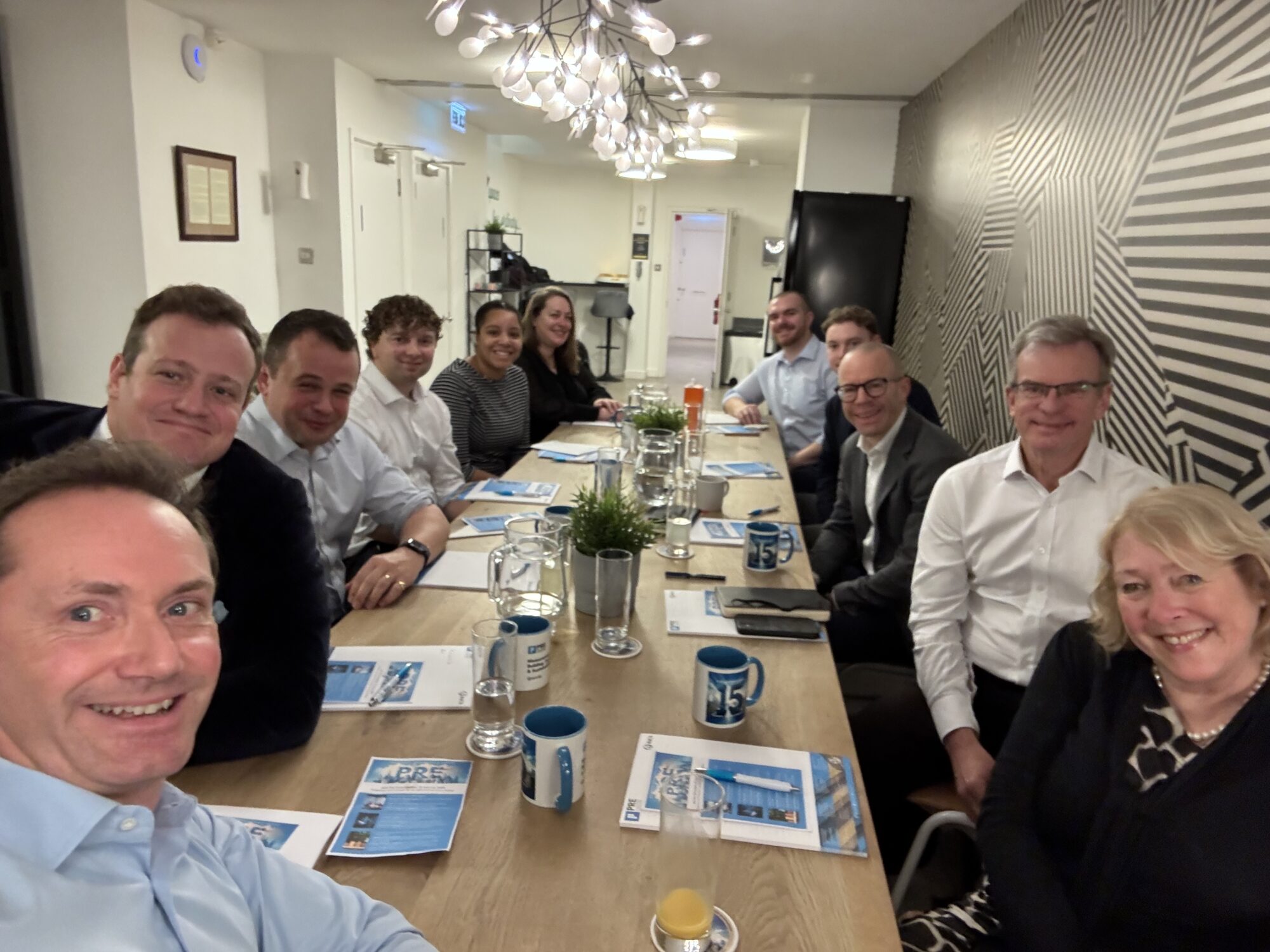News
ROUNDTABLE BREAKFAST: 🌇 Predictions and Forecasts for the 2025 🇬🇧 UK Real Estate Market

"To start off 2025 with a positive bang PRE hosted a selected mixture of clients for breakfast and networking in a relaxed atmosphere at our HQ offices in Soho, London. The roundtable discussion offered a unique opportunity to connect with peers, gain fresh insights, and shape strategies for 2025 and beyond".
Jason Antill, Managing Director PRE

Discussion Highlights
1. The Evolution of Office Space

Demand for flexible leases: Are traditional long-term leases becoming obsolete?
“The relevance of traditional long leases in the UK commercial real estate market is evolving, though it would be premature to label them as entirely obsolete. Several factors are driving this shift:
Why Long Leases Are Becoming Less Common
Increased Demand for Flexibility:
Businesses are seeking greater agility in their real estate strategies, especially post-Covid. Flexible leases allow tenants to adapt to changing market conditions, workforce strategies, and operational needs. Growth in hybrid work models has reduced demand for long-term commitments to office spaces.
Rise of Serviced and Co-Working Spaces:
Providers like WeWork and Regus offer short-term, flexible contracts with plug-and-play solutions, which appeal to startups, SMEs, and even larger companies needing satellite offices. These options make traditional long leases less”
Hybrid work’s lasting impact: What will be the balance between remote work and office space needs.
“Evident that different companies have approached hybrid work differently both across the UK & internationally:
Larger companies have shown a desire to have workforce return to the office. These companies have prioritised in person discussions and interactions as they view it helps with workflow.
Smaller firms have shown they tend to pursue the opposite approach with WFH being prioritised. Some firms have found this improves worker morale.
For firms that already had a form of hybrid working pre-COVID (surveyors & architects going to site visits), the idea of splitting time between the office & other locations has not been difficult to adapt to”.
Repurposing and redesigning: How will office spaces adapt to foster collaboration and attract tenants?
“Growing demand for more decorative and interactive spaces which tenants will find attractive and worthwhile to spend their money on.
Designers have seen a growing focus on more intricate decorations such as flowers and decorative finishes which help to make offices feel more enticing and comfortable.
Difficulty conducting rent reviews for CAT A+ offices as it is hard to discern what can be included in the value of the space.
Designers have found that it is difficult to achieve a blanket design specification as tenant requirements can vary greatly”.
2. Rising Interest Rates and Investment Shifts

Investor caution: How are rising interest rates affecting investor appetite and risk tolerance?
“Rising interest rates in the UK have significantly impacted investor appetite and risk tolerance in the commercial real estate market. Higher borrowing costs, increased uncertainty, and tighter financial conditions are driving changes in investor behavior:
Impact on Investor Appetite
- Reduced Demand for Leveraged Investments:
- Higher interest rates increase the cost of debt, making it more expensive for investors to finance property acquisitions.
- Many investors are stepping back from highly leveraged deals, particularly for assets with lower yields.
- Shift to Higher-Yielding Assets:
- Investors are seeking properties with stronger income streams to offset higher financing costs. This includes assets like logistics centers, retail warehouses, and prime office buildings with long-term, secure tenants.
- Selective Acquisitions:
- Rising rates have caused some investors to adopt a “wait and see” approach, particularly in sectors like retail and secondary office markets, where demand is weaker and risks are higher.
- Core assets in prime locations remain attractive but face downward pressure on pricing due to reduced competition.
Impact on Risk Tolerance
- Focus on Stability:
- Risk-averse investors are prioritizing stable, income-producing assets over speculative development projects or properties with high vacancy rates.
- Long-term leases with creditworthy tenants are particularly appealing in a rising-rate environment.
- Valuation Adjustments:
- Higher rates lead to increased yield expectations, pushing down property values. Investors are reassessing their tolerance for risk in light of declining capital appreciation potential.
- Some are exiting markets where price corrections are anticipated to mitigate exposure.
- Increased Due Diligence:
- Investors are scrutinizing assets more closely, focusing on factors like tenant credit quality, location resilience, and market fundamentals to minimize risk.
Opportunities in a Higher Rate Environment
- Distressed Assets: Rising rates may create opportunities to acquire distressed or undervalued assets as leveraged owners face refinancing challenges.
- Alternative Sectors: Niche markets like data centers, life sciences facilities, and student housing are attracting interest due to their stable demand and growth potential.
While higher rates temper investor appetite and reduce risk tolerance, they also encourage a more disciplined approach, with a focus on sustainable, long-term returns”.
Institutional investments: Will we see more emphasis on alternative asset classes, like lifesciences and data centres?
“Growing use of permitted development for residential developments; however, should there be an increased amount of oversight to make sure homes are of good quality?
Local governments are able to limit the use of permitted development through Article 4
Should there be increased scrutiny within the Permitted Development rights? Would this lead to it becoming another form of planning instead of the fast track option it currently is.
Investment in Old Age/Retirement properties has seen an increase:
It is important that retirement homes are provided with amenities such as food production, healthcare and social spaces
Increased demand for data centres as more companies are using the cloud to store and distribute data”.
Financing challenges: Are new funding models or partnerships emerging in response to tighter credit conditions?
“Yes tougher credit conditions in the UK have spurred the emergence of new funding models and partnerships as investors and developers adapt to rising interest rates and reduced access to traditional financing. These strategies aim to mitigate financial risks, share costs, and unlock alternative sources of capital.
Emerging Funding Models and Partnerships
- Joint Ventures (JVs):
- Developers and investors are increasingly forming JVs to share financial risks and pool resources for large-scale projects.
- Institutional investors, such as pension funds, partner with experienced developers to access opportunities without taking on full exposure.
- Example: Large mixed-use developments or infrastructure-led projects often involve partnerships between public and private entities.
- Equity Partnerships:
- Equity co-investment models are gaining traction, where investors provide upfront capital in exchange for a share of future profits rather than relying solely on debt.
- Family offices, high-net-worth individuals, and private equity firms are becoming more active in such arrangements.
- Mezzanine Financing:
- Mezzanine debt, which combines debt and equity characteristics, is being used to fill funding gaps.
- This option appeals to developers who may struggle to secure traditional loans or want to reduce equity dilution.
- Private Credit and Alternative Lenders:
- Non-bank lenders, including private credit funds and debt funds, are”.
3. Sustainability and Compliance Pressure in Commercial Real Estate

Meeting ESG standards: Are landlords and developers keeping up with regulatory pressures and tenant demands for green buildings?
“Whilst it is noticeable that there is an increased focus on achieving ESG goals, it is clear that the focus is not distributed equally with greater attention being paid to the environmental aspects.
Social aspects and Corporate Governance have fallen behind the environmental focus”.
Energy efficiency upgrades: How will retrofitting for carbon neutrality impact property values and attractiveness?
“Increasing desire to improve energy efficiency amongst Landlords and tenants as it will help to reduce running costs in the long-term.
With the incoming requirement for all commercial properties to achieve an EPC rating of ‘B’ by 2028 will see a rush in retrofitting offices spaces; however, the cost to do so will be great. This issue opens up a discussion on who will foot the bill for these upgrades? Will tenants be required to complete the work if they have a full repairing and insuring lease? Will rents rise to accommodate expenses if the landlord completes the work?
Could we see increased funding schemes to help pay for upgrades”.
Future-proofing assets: What sustainability innovations are leading the way in new developments?
“Consensus that it will be difficult to adequately maintain future-proofing as there is an ever changing stock of technology and tenant desires meaning it is hard to pinpoint what changes are needed”.
